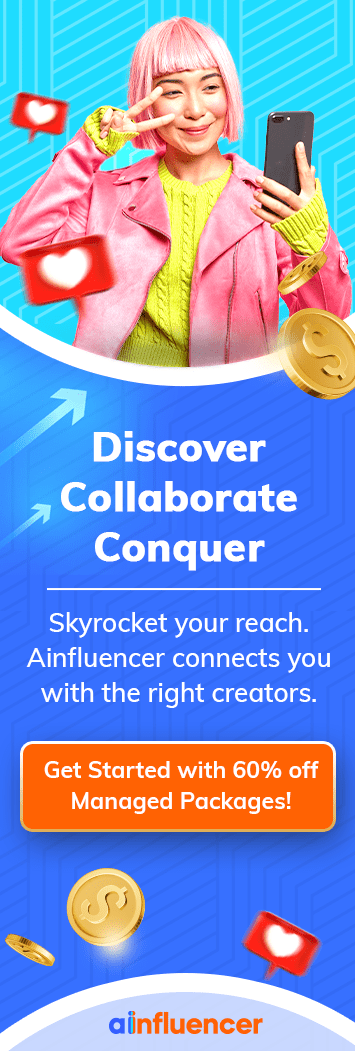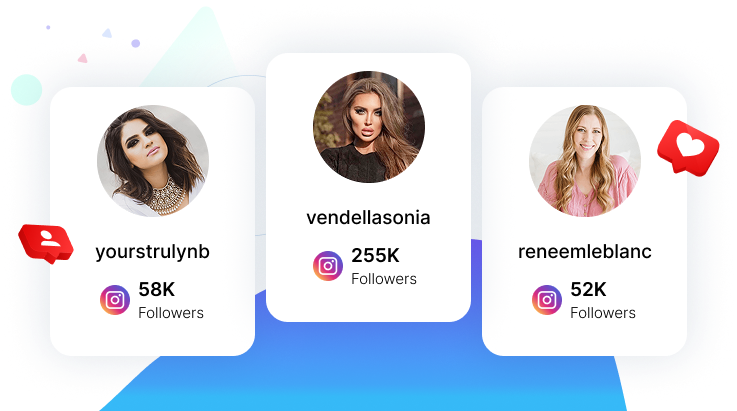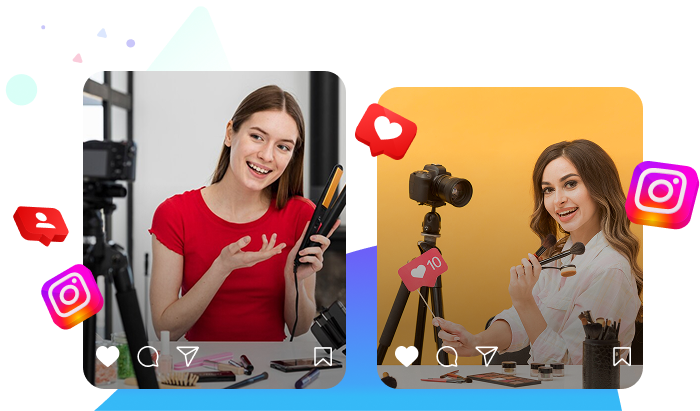Finding the right influencer for your brand can feel like searching for a needle in a haystack. You want someone who speaks to your audience, aligns with your values, and delivers real impact. But that takes time, research, and negotiation. This is where influencer marketplaces come in to rescue you.
A few years ago, brands had to put their trust in digital marketing or influencer marketing agencies to find a suitable influencer for them. You can probably guess that this approach had a few problems.
1) Agencies’ fees are high, which made brands cut their budget, and so the influencers they could choose were narrowed down.
2) An agency that only knows your brand through a contract can never truly understand your business. And so, there were times when the wrong influencers were chosen, the campaign failed, and time and resources were wasted.
But this all changed with the emergence of influencer marketing platforms. These platforms were made so that brands could search and find influencers on their own, and as a result, there was a drastic change in influencer marketing campaigns.
In this blog, I’ll review the top 29 Influencer marketplaces with details. I’ll review their features, pros & cons, users’ reviews, and so on. By the end of the blog, you can surely choose the best influencer marketplace based on your criteria. Let’s dive in!
What Is an Influencer Marketplace?
Let’s start from the very beginning. An influencer marketplace is a digital marketplace where brands and influencers (aka creators or content creators) find each other and collaborate. How?
On these platforms, different types of influencers, from mega to nano influencers, register and provide details about themselves, including their niche, past collaborations, and other relevant information.
Meanwhile, brands searching for the right influencers for their campaigns use filters such as niche, platform, and audience demographics to find suitable candidates.
Once a match is made, brands and influencers can begin discussions about the campaign, negotiate terms, and align on goals.
Put simply, an influencer marketplace links brands with content creators. It is often called an influencer marketing marketplace, creator marketplace, or even a social media influencer marketplace, all meaning roughly the same thing.
Some marketplaces cover multiple social media, and some specifically gather influencers for just one platform or niche. For example, a TikTok influencer marketplace focuses on TikTok creators, while a YouTube influencer marketplace targets YouTubers.
Micro-influencer marketplaces help brands connect with nano/micro influencers, while macro-influencer marketplaces only register top-tier influencers with large followings. There are even B2B influencer marketplaces that link business-to-business brands with industry experts or thought leaders.
So, there are many types of marketplaces, and you should know them to have a successful influencer marketing campaign. In this blog, I tried to gather the ones that cover everything. These platforms cover multiple social media and all types of influencers.
Top 29 Influencer Marketplaces
Below is an overview of 29 leading influencer marketplaces, covering free tools, all-in-one platforms, niche services, and network-specific solutions.
I provide a brief description, key features, pros/cons, pricing, user feedback, and ideal use cases for each (This list includes marketplaces for creators and for brands).
Let’s start with the best one:
1. Ainfluencer: World’s First Free DIY Influencer Marketplace
At our #1 spot, we have Ainfluencer. This free influencer marketplace for both brands and creators connects brands with +5 million social media influencers on Instagram, TikTok, and YouTube.
Unlike most platforms, Ainfluencer charges no fees at all. It’s completely free to use and allows unlimited brand campaigns.
Key Features
- Influencer Discovery:
Ainfluencer provides access to a database of over 5 million active influencers on Instagram, YouTube, and TikTok, with 10,000 new creators joining monthly. Brands can search for influencers using an AI-powered search engine to find the perfect match for their campaigns.
- Smart Filters For Influencer Discovery:
Offers more than 20 advanced filters, including influencer size (nano, micro, macro, mega), platform, gender, location, age, audience demographics, engagement rate, and hashtags.
- Campaign Creation:
Brands can easily create unlimited campaigns by defining influencer criteria, campaign goals, and content requirements. The platform’s DIY setup allows for quick and customizable campaign launches without restrictions.
- Influencer Invitations
Brands can send unlimited invitations to influencers for collaboration. There are no caps on the number of invites, enabling brands to reach out to as many creators as needed to build their campaign.
- In-App Messaging
A built-in chat feature allows brands and influencers to communicate directly within the platform. This streamlines negotiations, discussions about content, and collaboration terms, keeping all communication organized.
- Escrow Payment System
Ainfluencer provides secure transactions by holding collaboration fees in a trusted escrow system. Payments are released to influencers only after the brand confirms the content meets campaign requirements, protecting both parties.
- Influencer Insights and Analytics
Brands can view detailed profiles of influencers, including past collaborations, engagement metrics, audience demographics, collaboration costs, and authentic social media screenshots. This helps brands make informed decisions about partnerships.
- Campaign Management
The platform provides tools to manage multiple campaigns simultaneously, including tracking influencer content, monitoring progress, and organizing collaborations. Brands can oversee all aspects of their campaigns from a single dashboard.
- Influencer Rating System
After collaborations, brands can rate influencers based on their performance, and these ratings are visible on influencer profiles. This helps other brands identify reliable creators and fosters trust within the platform.
Pricing
Completely free with no hidden fees. The platform only takes 20% commission from the Influencers’ transactions.
Pros & Cons of Ainfluencer
| ✅Pros | ❌Cons |
| Free forever; no hidden fees | Primarily suited for growing brands and micro-influencers. |
| Large influencer pool | |
| easy to use for small budgets. | |
| Targeted matchmaking |
User Reviews
Now let’s get to the main part, the users’ review. Let’s see how Ainfluencer has performed and what users think.
Starting with G2, where Ainfluencer has managed to get a 5-star rating, which is very impressive.
Users praise Ainfluencer’s ease and cost-free model. A G2 review notes it’s “100% free” and emphasizes its all-in-one nature. Another mentions that Ainfluencer “really makes finding the right influencers easy” with verified profiles.
Let’s see how Ainfluencer performed in other rating communities like Trustpilot:
Users praise this platform on Trustpilot, too. One reviewer noted it’s “the best influencer platform” due to its free plans and ease of use.
Ideal Use Cases
Small businesses, startups, and creators on a budget. Great for micro-influencer campaigns and social media influencer marketplace needs.
By now, you know why Ainfluencer is the best influencer marketplace for brands and influencers. So, give it a try and watch your business grow like you never imagined!
Create a Free Account2. Afluencer
Afluencer is another influencer marketplace that helps brands of all sizes find Instagram and TikTok creators. It’s popular among small brands and micro-influencers. Afluencer provides search filters and enables brands to invite influencers directly to campaigns.
Key Features
- Influencer Discovery
- Advanced Search Filters
- Campaign Creation
- Collab Proposals
- In-App Messaging
- Campaign Management
- Influencer Analytics
- Collaboration Preferences Filter
Pricing:
Although Afluencer claims it’s a free influencer platform, it’s not. It only offers a single free plan, with limited features, and is only available for influencers:
For brands, Afluencer’s plans are all paid, and there are no free ones. But plans start at $49, which could be affordable.
Pros & Cons of Afluencer
| ✅Pros | ❌Cons |
| Low cost | Limited Influencer Pool for Specific Niches |
| Intuitive matchmaking | Restricted Free Plan Features |
| No iOS Mobile App | |
| Inconsistent Customer Support |
User Reviews
Users on Trustpilot like the platform, but some are not happy with their customer support.
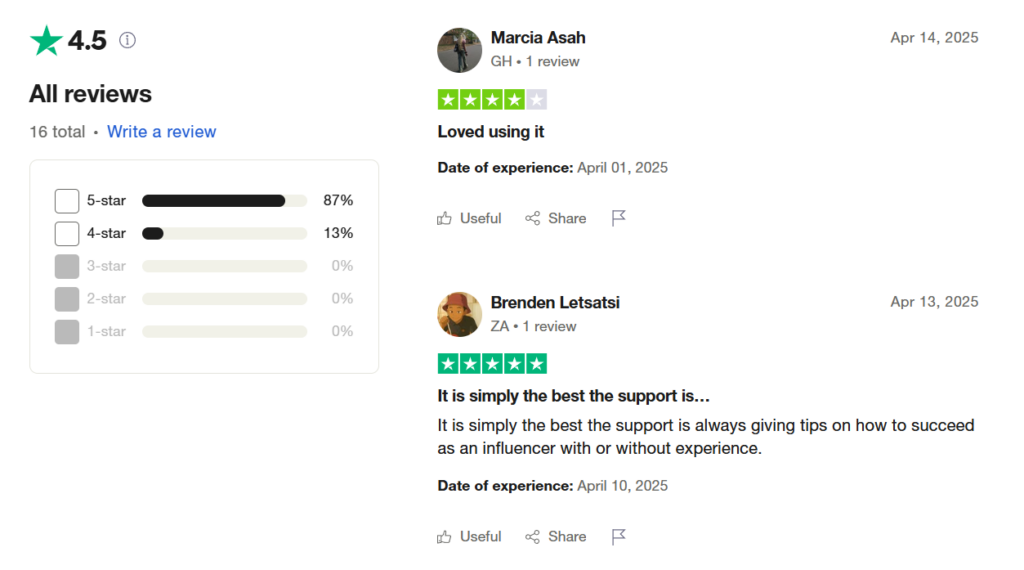
Ideal Use Cases
Influencer marketplace for brands on a budget and creators (especially micro-influencers) looking to find campaigns. It is good for campaigns targeting both Instagram and TikTok audiences.
3. #paid (HashtagPaid)
#paid (HashtagPaid) is an influencer marketplace that carefully selects creators using both AI and human review. Brands use their system to find the best-matched influencers. It’s a popular choice for companies looking for trusted partnerships with vetted creators.
Key Features
- AI-driven matching + manual vetting
- a marketplace for brand “pitch requests”
- Campaigns can be posted, and creators can apply
- Works globally with a heavy focus on quality
- Provides full campaign management (creative briefs, contracts, payments).
Pricing
For Brands:
- Just Content Plan: $499/month (monthly) or $449/month (annually) for content creation with creators.
- Grow Plan: Custom pricing (likely $700–$1,500/month), includes whitelisting and advanced campaign tools.
- Enterprise Plan: Custom pricing for large-scale campaigns with unlimited searches and dedicated support.
For Influencers:
- No Cost to Join: Free to apply and join the marketplace.
Pros & Cons of #paid
| ✅Pros | ❌Cons |
| Highly targeted influencer recommendations and brand safety | High cost for brands ($449+/month). |
| top-rated customer support | Entry-level plans have feature caps |
| Self-service workload on lower plans | |
| Learning curve for advanced tools. |
User Reviews
Overall, #paid has received good reviews and is highly regarded for its user-friendly platform, strong analytics, and effective campaigns. Still, its cost and minor usability issues may challenge smaller brands or users needing more mobile access.
Ideal Use Cases
Mid-size to large brands and agencies that need an end-to-end influencer marketing solution. It’s an ideal B2B influencer marketplace for campaigns where quality and targeted reach (especially on platforms like Instagram and TikTok) are critical. Not suitable for small businesses or small budgets.
4. inBeat
inBeat is a content creator marketplace focused on user-generated content (UGC) and micro-influencers, especially on TikTok and Instagram. It positions itself as a way for brands to get fresh, authentic content from creators.
Key Features
- Influencer discovery (filter by category, interests, content type)
- campaign briefs and tracking; payments
- Emphasizes short-video and TikTok partnerships (though it supports IG as well)
- Creators are incentivized to produce UGC for brands.
Pricing
Pricing typically is around $200-$1000 per month, depending on the services included and the scale of the campaign.
For brands with specific needs or larger campaigns, inBeat provides custom quotes tailored to individual requirements.
Pros & Cons
| ✅Pros | ❌Cons |
| Free for influencers to join, with campaign earnings | Limited to Instagram/TikTok, no YouTube or blogs. |
| Strong analytics and contact export tools | No in-app messaging or API integration |
| Not so budget-friendly | |
| Occasional support delays reported |
User Reviews
There are mixed reviews about the inBeat agency; some praise it, and some are not so happy with it.
Here are the pros and cons of this agency based on users’ reviews:
Ideal Use Cases
DTC and consumer brands, especially e-commerce, want lots of on-trend video content. Great for brands running TikTok or Reels campaigns and seeking an influencer marketing marketplace that emphasizes creative UGC output. Also good for small businesses on a limited budget.
5. SocialBook
SocialBook is an influencer marketing platform with a focus on data and CRM. It offers an extensive database of influencers and comprehensive analytics. It’s used by brands, agencies, and even creators themselves to manage campaigns end-to-end.
Key Features
- Extensive influencer database (claims 3+ million indexed accounts)
- AI-powered search across Instagram, YouTube, TikTok
- Detailed audience analytics (demographics, engagement history)
- Campaign tracking
- CRM inbox for messaging
- Competitor analysis
Pricing
SocialBook offers three different plans for brands working with influencers, but it hasn’t disclosed what each of these plans includes or what services they offer.
Pros & Cons of SocialBook
| ✅Pros | ❌Cons |
| Userfriendly interface | Brand Challenges |
| Robust Analytics | Learning Curve |
| Poor customer support | |
| Technical Issues | |
| No clear description of plans |
User Reviews
Socialbook has received mixed reviews from users. On Trustpilot, this platform has received a score of 2.6/5, which isn’t very promising:
But in other rating communities, Socialbook has managed to get more positive reviews. For example, here are some on G2:
I have to mention that the reviews on G2 seem a bit staged. A lot of them sound very similar, and they all say there’s nothing they would change about SocialBook.
They say, “SocialBook made my life easier”, or “I was living under a rock before using SocialBook.” It feels exaggerated and a little too perfect, like the reviews were carefully written rather than real opinions.
Ideal Use Cases
Mid-market to large brands and agencies that require advanced search and reporting. Good for multi-channel campaigns (Instagram + YouTube). Also useful for creators who want to join as ambassadors.
6. Collabstr
Collabstr is a popular marketplace that connects micro- and nano-influencers with brands. Unlike SaaS platforms, Collabstr operates on a gig-order model: influencers set fixed rates, and brands can purchase posts or videos directly.
Key Features
- Influencers list their rates and services
- Brands can browse profiles, filter by engagement and platform, and order content
- Payment is handled within Collabstr for safety
- Collabstr supports Instagram, TikTok, YouTube, Twitter, and more.
Pricing
Collabstr offers three different subscriptions:
Pros & Cons of Collabstr
| ✅Pros | ❌Cons |
| Easy-to-use interface for finding and managing influencers. | Limited customer support responsiveness reported by some users |
| Real-time performance tracking and analytics | Occasional bugs in the platform, such as slow chat updates |
| Refund policies and transparency have been criticized by users | |
| Not ideal for large-scale campaigns requiring extensive customization |
User Reviews
Collabstr has received a score of 4.2/5 on Trustpilot and is mostly considered a good platform by users; many praise it.
However, there are some problems too. For example, analytics depth is a recurring issue. Also, some users have reported scammer influencers on the platform.
Ideal Use Cases
Small businesses and solo entrepreneurs looking for micro influencer marketplace solutions. Also, creators who want an easy way to offer services. Ideal for simple one-off collaborations, like a fashion influencer posting a sponsored pic.
7. Activate (by Impact/Klear)
Activate (formerly known as Klear’s Activate) is an enterprise-level influencer marketplace now part of Impact.com. It offers a full suite: discovery, recruitment, relationship management (IRM), and measurement.
Key Features
- Advanced search and “casting lens” filters
- analytics and ROI tracking
- Influencer relationship management
Pricing
Enterprise pricing (quote-based).
Pros & Cons
| ✅Pros | ❌Cons |
| Comprehensive and professional | Only 75000 influencers |
| Operates in multiple countries | No clear pricing details |
| Not suitable for small to mid businesses | |
| Limited public reviews |
User Reviews
There aren’t any online reviews about this platform, and it’s hard to find extensive user feedback on the platform’s effectiveness.
Ideal Use Cases
Large enterprises and agencies managing influencer programs at scale, or brands that need deep influencer insights.
8. HypeAuditor
HypeAuditor is a data-focused influencer marketing platform known for audience authenticity metrics. It uses AI to analyze influencers’ followers for fake/fraudulent activity and provides deep analytics on audience demographics. It’s often used for due diligence and reporting.
Key Features
- AI-driven Audience Quality Score (AQS)
- Detailed demographic analysis (age, location, interests)
- Brand safety checks to ensure no offensive content
- Influencer search & discovery tools
- Campaign management (mass outreach, templates, email tracking)
- ROI and conversion tracking integrations
Pricing
Custom (on request). No free plan.
Pros & Cons of HypeAuditor
| ✅Pros | ❌Cons |
| Strong Fraud Detection | Pricing is enterprise-level, not suitable for small businesses |
| Strong Analytics | Unexpected charges |
| No In-app Chat | |
User Reviews
HypeAuditor has received a good score of 4 stars on G2, reviews highlight its analytics accuracy and user-friendly interface for data. Many users cite the AQS and audience analysis as invaluable.
However, like every platform, some users weren’t happy with the platform. Unfortunately, HypeAuditor has 2.6 stars on Trustpilot.
Ideal Use Cases
Brands and agencies that require macro influencer marketplace capabilities with emphasis on data integrity. Essential when fraud is a concern. Also good for global campaigns needing multi-country audience insights.
9. GRIN
GRIN is an influencer marketing platform designed to help brands manage their creator partnerships efficiently. It offers tools for influencer discovery, campaign management, content tracking, and ROI analysis.
Key Features
- Built-in influencer discovery
- Bulk campaign management (briefs, content reviews, fulfillment)
- E-commerce integration
- Reporting on ROI, sales, and engagement all in one place.
Pricing
Quote-based (typically several thousand USD per year for a mid-sized brand).
Pros & Cons
| ✅Pros | ❌Cons |
| User-friendly UI and robust support. | Custom, high pricing |
| Supports affiliate programs | Annual subscription required (no micro-tier) |
| The system can be complex if you don’t need deep e-commerce features | |
| Content tracking limitations | |
| Payment system complexity |
User Reviews
GRIN has received mixed reviews; some users like the ability to tailor campaigns and landing pages to fit their brand’s needs and like the platform.
And some have had issues using it. Some influencers have experienced problems keeping their social media accounts connected to the platform.
Also, the platform does not allow users to pull a complete list of influencer-generated content over a specific period, which makes tracking difficult.
Ideal Use Cases
E-commerce brands with significant influencer marketing budgets. It is a top influencer marketplace for brands that run affiliate or ambassador programs, especially if they need to sync with their Shopify/WooCommerce stores.
10. Brandbassador
Brandbassador is an ambassador marketing platform that scales micro-influencer programs. It’s built to help e-commerce brands grow via word-of-mouth and affiliate-style campaigns. Unlike rigid marketplaces, it focuses on long-term brand ambassadors.
Key Features
- Invite brand supporters to become ambassadors
- Track advocates’ sales through unique links/codes
- Content submission and review
- Gamified rewards
- Referral programs and social sharing metrics.
Pricing
Brandbassador offers four different plans, but doesn’t disclose any pricing details about them, and users have to contact Brandbassador for pricing.
Pros & Cons of Brandbassador
| ✅Pros | ❌Cons |
| Very scalable ambassador system | Less suitable for one-off influencer campaigns |
| ideal for steadily growing a network of micro-influencers | Primarily UK/EU-focused (though global now) |
| The setup is more like a loyalty program than a pure marketplace | |
User Reviews
Brandbassador hasn’t received too many positive reviews from users.
But some users find this platform very helpful, easy to use, and legit.
Ideal Use Cases
DTC brands are looking to turn customers into brand ambassadors. Great for startups building influencer programs from the ground up. Useful when your “influencer marketplace for creators” is actually your own community.
11. Captiv8
Captiv8 is an enterprise influencer marketing platform used by large brands and agencies. It combines discovery, analytics, campaign management, and content rights management in one place. Captiv8’s focus is on visual content and performance metrics.
Key Features
- Influencer search by audience demographics and psychographics
- Workflow for campaign and content approval
- Automatic tracking of media value (EMV) and ROI
- Integration of legal contracts and rights management
- Multi-platform coverage (IG, TikTok, YouTube, etc.).
Pricing
Enterprise (quote-based).
Pros & Cons
| ✅Pros | ❌Cons |
| Comprehensive enterprise tool | High Pricing |
| Strong analytics | Not suitable for small businesses |
| Primarily for agencies and Fortune 500 brands | |
| Influencer authentication issues |
User Reviews
Users note Captiv8 as powerful but complex. It’s “award-winning” in design, but most insights come from case studies rather than user quotes.
Ideal Use Cases
Corporations and agencies running multi-channel, multi-market campaigns. Not for small businesses.
12. CreatorIQ
CreatorIQ is a leading influencer marketing platform built for large enterprises and global brands. It offers a unified system to discover influencers, activate campaigns, and measure results at scale.
Key Features
- AI-powered influencer search and recommendation
- Advanced campaign management with team collaboration
- Measurement dashboards linking influencer exposure to web traffic and sales
- Integration with Salesforce, Adobe, etc
- Analytics database of billions of data points
Pricing
Pricing is available on request.
Pros & Cons of CreatorIQ
| ✅Pros | ❌Cons |
| Comprehensive influencer discovery with AI-backed insights. | Very high price point |
| Fraud detection ensures authentic influencer partnerships. | Lengthy implementation |
| Best suited when you have large influencer budgets | |
| Requires time to fully understand and utilize all features effectively. |
User Reviews
CreatorIQ is praised for its detailed influencer insights, strong reporting tools, and responsive customer support, making campaign management more efficient.
However, some find the interface clunky, analytics outdated, and influencer discovery limited. Also, frequent technical issues and payment troubles lead to frustration and more reliance on customer support.
Ideal Use Cases
Global consumer brands and large companies (e.g., technology firms or automotive brands) that need detailed tracking and cross-platform integration.
13. Traackr
Traackr is a SaaS platform for influencer relationship management and analytics. It combines influencer discovery with long-term relationship tracking. Traackr emphasizes metrics like audience growth and contextual brand fit.
Key Features
- Search 10M+ influencer profiles
- Track influencer network relationships (CRM)
- Campaign planning
- Detailed analytics including Klear/Synthesio social listening (Traackr acquired Synthesio for audience insights).
Pricing
Enterprise (quote-based).
Pros & Cons of Traackr
| ✅Pros | ❌Cons |
| Comprehensive tracking. | No mobile app, limiting on-the-go access. |
| Strong global insights. | Premium pricing (custom plans). |
| Steep learning curve (Reddit reviews). | |
| Some users report occasional bugs and slow platform performance. |
User Reviews
Traackr has received mixed reviews, but overall, we can say it’s a good platform. Many users like it, but many reviews mention the technical glitches and slow loading of the platform, which makes it frustrating to work with.

Also, there were users who mentioned, “Sometimes, not all the correct accounts are linked to a creator, especially if they have multiple ones.”
Ideal Use Cases
Brands appreciate its “relationship management” focus for continual influencer partnerships. Not widely published in free reviews, but the platform is respected in enterprises.
14. Klear
Klear (now part of Upfluence/Impact) is an influencer discovery and analytics tool known for its deep influencer profiles. It uses social data to score fit and performance.
Originally, Klear was a standalone platform; However, its technology underpins some other products now. Also, Klear’s founders created Activate, so it’s tied to a broader suite.
Key Features
- Influencer search with filtering by topic, location, and social network
- Detailed influencer profiles (audience demographics, previous brand deals)
- Campaign management and basic analytics.
Pricing
Enterprise (quoted on request).
Pros & Cons of Klear
| ✅Pros | ❌Cons |
| Very accurate search | Expensive, less accessible for small businesses. |
| Known especially for Instagram and Twitter insights | Limited support for newer platforms like TikTok. |
| Basic analytics | |
| Smaller database; less intuitive UI |
User Reviews
There aren’t as many reviews about Klear as there were for previous platforms, which could be considered a negative point for a famous platform.
The most recent review I found goes back to 2023, where users mentioned Klear is not playing as strongly as its competitors. Also, there were problems with payments.
Ideal Use Cases
Brands that already use Impact.com or AspireIQ might find Klear features integrated. Good for influencer market research and social listening.
15. LTK (RewardStyle)
LTK (formerly rewardStyle) is a marketplace focused on retail, lifestyle, and fashion influencers. It’s more of an affiliate platform where influencers share shoppable links. Brands (retailers) can list products, and creators can earn commissions on sales.
Key Features
- Shopping links (in-app link generation)
- Content management
- A large network of fashion/lifestyle influencers and bloggers
- Analytics on link clicks and conversions.
Pricing
LTK offers three annual plans:
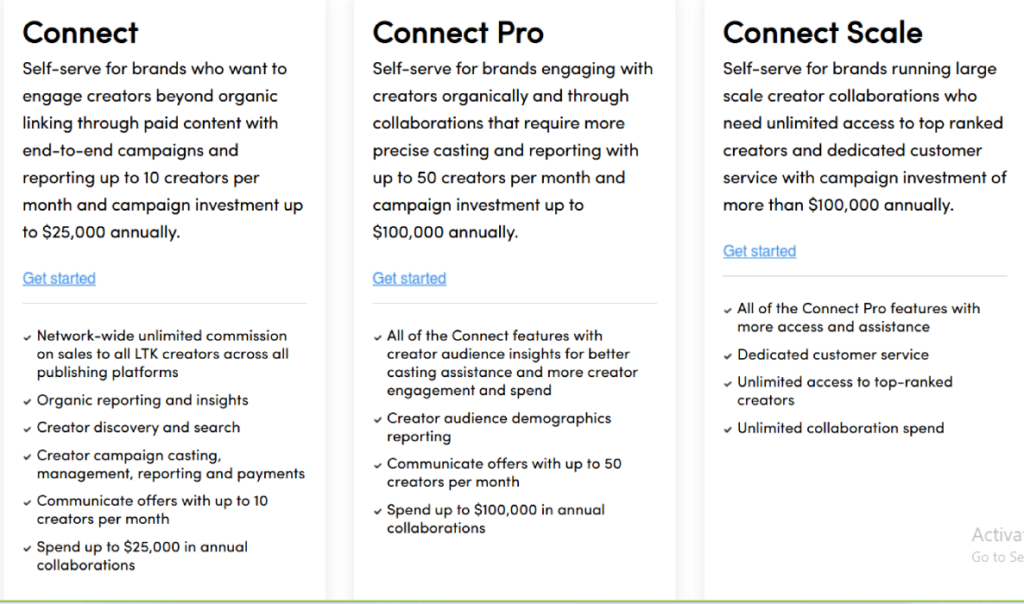
Pros & Cons of LTK
| ✅Pros | ❌Cons |
| Large network of creators, especially fashion and lifestyle influencers | High pricing |
| Comprehensive affiliate marketing tools | Not suitable for small businesses |
| Limited flexibility for non-fashion industries | |
| Outdated creator profiles |
User Reviews
Once again, I couldn’t find many reviews about LTK, which is a negative point for a worldwide platform. Anyway, there were some mixed older reviews, but overall, users all agreed that LTK is overpriced.
Another user mentioned, “The platform is basic, and the timing of campaigns makes no sense.”
Ideal Use Cases
Retail brands (apparel, beauty, lifestyle) are looking to leverage creator link sharing. An indirect form of an influencer marketplace focused on commerce.
16. IZEA
IZEA is one of the oldest influencer networks. It acts as a marketplace and agency for influencer content. Brands and agencies can use IZEA to find influencers, manage sponsored content, and run affiliate campaigns.
Key Features
- Talent marketplace (search influencers)
- Content sponsorship (blog posts, social posts, videos)
- Affiliate program management
- Offers an ad network called “IZEAx” for programmatic influencer placements.
Pricing
Custom pricing
Pros & Cons of IZEA
| ✅Pros | ❌Cons |
| Experienced team | User interface is dated. |
| Flexible – supports many content types (articles, tweets, posts) | Community feedback indicates that the platform can be buggy |
| Filtering influencers to find the perfect match can be time-consuming |
User Reviews
Unlike previous platforms, IZEA has some pretty authentic reviews on websites like Trustpilot and G2. We’ll go through both of them:
Here’s what users say about IZEA on Trustpilot:
Reviews seem to be better on G2, and users mention that finding influencers with IZEA is very easy:
Ideal Use Cases
Large companies or agencies wanting an all-in-one for sponsored content and affiliates. IZEA can be seen as a full influencer marketing marketplace with additional affiliate features.
17. Onalytica
Onalytica is a B2B influencer marketplace that combines influencer identification with employee advocacy and earned media. It’s often used by B2B and tech companies.
Key Features
- Global influencer search across social + blogs
- Tools for employee advocacy (sharing content through employees)
- Influencer relationship manager and analytics.
Pricing
Quote-based.
Pros & Cons of Onalytica
| ✅Pros | ❌Cons |
| Strong for technology and B2B sectors (engineering, finance, healthcare). | More focus on research than quick campaigns |
| Not suitable for all niches |
User Reviews
Unfortunately, I couldn’t find any recent reviews about Onalytica. Reviews date back to 2021 and even 2018; this is a major downside.
It might mean the platform lacks recent feedback, hasn’t evolved much, or isn’t actively discussed anymore. This makes it harder to judge its current performance and relevance.
Ideal Use Cases
Large companies (especially B2B) that treat influencers as industry experts. Works as an influencer marketplace for thought leadership.
18. Upfluence
Upfluence is an all-in-one influencer marketing platform that also includes affiliate marketing. It provides discovery, CRM, campaign management, and even ChatGPT-powered tools for creators.
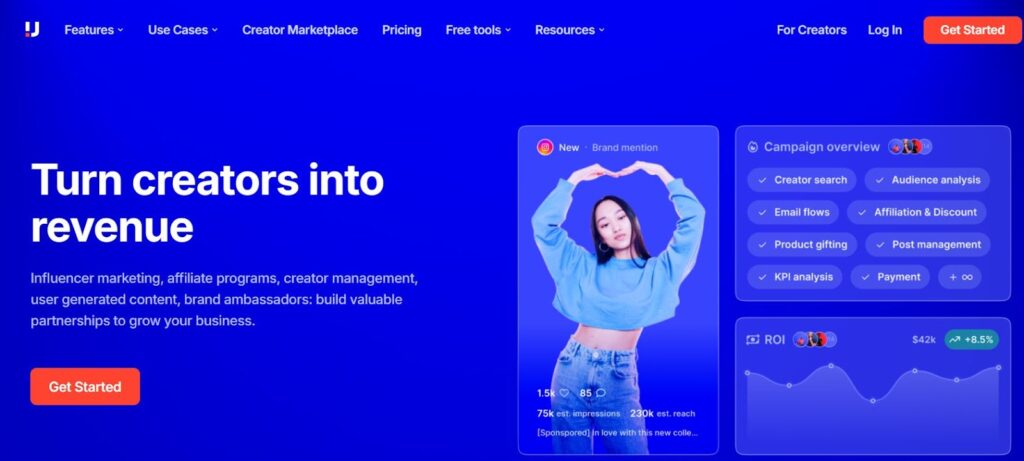
Key Features
- Powerful influencer search
- Multi-channel campaign management
- Affiliate program integration
- Influencer payments
- Data dashboards
- AI-enhanced features for scaling content.
Pricing
Upfluence has turned its pricing into custom quotes.
Pros & Cons of Upfluence
| ✅Pros | ❌Cons |
| Extensive creator database (Instagram, TikTok, YouTube, Twitch, etc.). | Customer Support Issues |
| Easy-to-use interface | Billing Concerns |
| Complex Setup | |
| Influencer Management Limitations |
User Reviews
Upfluence has received mixed reviews from users. Some users appreciate the platform’s ability to find and connect with relevant influencers efficiently.
On the other hand, some other users disagree and even report unexpected charges and difficulties canceling subscriptions.
Ideal Use Cases
E-commerce and DTC brands that want to combine paid influencer content with affiliate/referral campaigns. A solid top influencer marketplace for growing businesses.
19. JuliusWorks
Julius is a user-friendly influencer search and campaign management tool, popular with mid-size brands. It has a database of vetted influencers and focuses on storytelling and brand fit.
Key Features
- Large search database
- Campaign management
- Real-time influencer analytics
- Emphasizes visual campaigns (Instagram, YouTube, Pinterest)
- Offers exclusive influencer lists curated by industry experts.
Pricing
Quote-based.
Pros & Cons of JuliusWorks
| ✅Pros | ❌Cons |
| Good support and onboarding | Influencer Discovery Limitations |
| Very intuitive and aesthetic platform | Technical Issues |
| Slow Performance | |
| No free plans |
User Reviews
Once again, I couldn’t find any new reviews about this platform. However, based on what I found, users describe Julius as “super easy to use” and highlight the visual campaign templates. However, some mention its limitations in influencer discovery.
Ideal Use Cases
Mid-tier brands (e.g., lifestyle and consumer goods) that want a polished dashboard and moderate budget influencer programs.
20. AspireIQ
AspireIQ, previously known as Revfluence, is a trusted influencer platform that helps brands build lasting partnerships. It supports both large and emerging companies in managing ongoing campaigns and content communities.
Key Features
- Influencer search
- Campaign automation
- Payment and contract management
- Brand-community building
- Content rights
- Integrated with Shopify/BigCommerce for e-commerce.
Pricing
Custom (enterprise scale).
Pros & Cons of AspireIQ
| ✅Pros | ❌Cons |
| User-friendly interface | Pricing on request, often high. |
| Detailed performance analytics | Costly for smaller brands (Reddit feedback) |
| Some users report outdated influencer profiles in the database. | |
| Limited to web-based access only, no mobile app | |
| Poor customer support |
User Reviews
Aspire hasn’t been very successful in satisfying customers, and reviews on Trustpilot aren’t very promising. Users have mentioned problems about payments, inappropriate behavior of employees and some other issues.
The reviews on G2 seem a little better, but they are not brand-new and date back to 2024. Users generally find AspireIQ easy to use, helping them track creators, manage campaigns, and process payments efficiently.
However, some find the platform’s layout unintuitive and onboarding difficult. Others report technical glitches, slow loading times, and limited support, often relying on chatbots or online help.
Ideal Use Cases
Growing to mid-large brands focused on building a brand ambassador network. All-round campaigns (Instagram, TikTok, email integration).
21. Modash
Modash is an influencer marketing platform with a strong emphasis on e-commerce. It offers influencer discovery plus automatic tracking of influencer posts and sales performance. It claims a database of 250+ million creators.
Key Features
- Influencer search across Instagram, TikTok, and YouTube
- Automated content collection
- Real-time campaign dashboards
- Built-in UTM link and promo code tracking for analytics
- Influencer payments and team collaboration tools.
Pricing
Modash offers three different plans, each with different accessibilities:
Pros & Cons of Modash
| ✅Pros | ❌Cons |
| Powerful for tracking e-commerce ROI | Paid only; pricing can be steep for large feature sets. |
| Large database | The large number of profiles can make it overwhelming to narrow down searches |
| More suited to brands rather than individual creators | |
| Inaccuracy in certain data points |
User Reviews
Users generally appreciate Modash for its ease of use, detailed influencer insights, and efficient campaign tracking. Many highlight its fast customer support and regular feature updates, making it a reliable tool for influencer marketing.
However, some users mention credit limitations, a steep learning curve, and occasional inaccuracies in data. Others find the platform’s complexity challenging and note that it could improve its brand coverage.
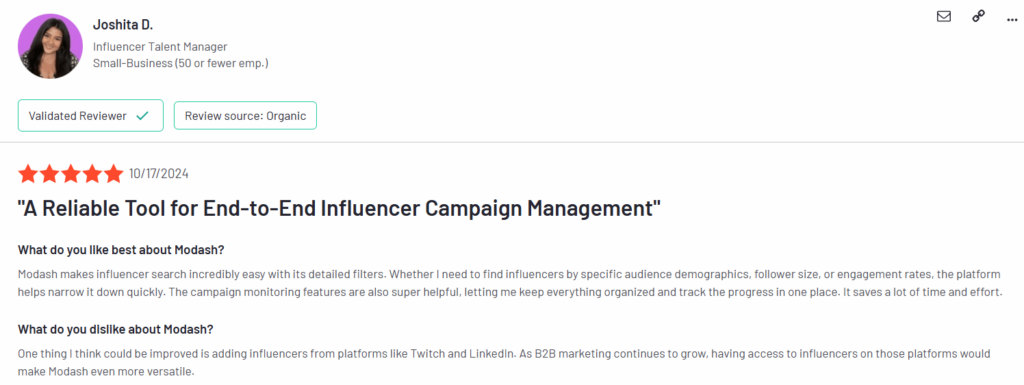
Ideal Use Cases
An ideal influencer marketplace for brands that want UTM, promo code, and sales tracking built in. Also suitable for E-commerce brands that need to ”run campaigns from start to finish” with data-driven tracking.
22. TrendHERO
TrendHERO is an influencer marketing platform focused on Instagram analytics. It helps brands and marketers audit influencers, detect fake followers, and analyze engagement metrics to ensure effective collaborations.
Key Features
- Influencer discovery
- Competitor analysis
- Account analytics
- Fake follower detection
- Influencer outreach
- Hashtag analytics
- Campaign tracking
Pricing
TrendHERO offers several pricing plans to suit different needs. Each plan includes influencer discovery, audience analysis, and campaign tracking.
Pros & Cons of TrendHERO
| ✅Pros | ❌Cons |
| 14 days free trial | Works only with Instagram |
| User-friendly interface | Limited integration with other platforms |
| Affordable pricing | Some users report occasional data inaccuracies |
| Lack of a campaign monitoring tool | |
| Limited features, even on premium plans | |
| Lack of an in-app messaging tool |
User Reviews
Users like TrendHERO for its detailed influencer analytics, fake follower detection, and intuitive interface. They find it useful for checking blogger authenticity and tracking engagement.
However, some report slow processing for large accounts, reload issues, language inconsistencies, and subscription-based report expirations.
Ideal Use Cases
TrendHERO is best suited for social media managers, influencer marketing agencies, startups, and brands looking to verify influencer authenticity and optimize their Instagram marketing efforts.
23. Heepsy
Heepsy is an influencer marketing platform with powerful search filters. It’s known for its database of Instagram, TikTok, and YouTube influencers, and for tools that analyze profiles. Heepsy also offers Shopify integration for tracking sales from Instagram campaigns.
Key Features
- Advanced search (follower count, engagement rate, location, gender)
- In-depth analytics on profiles, including fake follower estimation
- Filters for niche and audience
- Campaign tools (list management, outreach)
- Exports to CSV. Shopify conversion tracking.
Pricing
Heepsy offers monthly and annual plans + a free plan with limited tools.
Pros & Cons of Heepsy
| ✅Pros | ❌Cons |
| Strong search and filter capabilities | The free plan is very limited |
| Includes features like Shopify integration for performance tracking | Full data access requires upgrading to paid tiers |
| Some large influencers are not covered. | |
| Limited customer support responsiveness reported by some users. |
User Reviews
User reviews are generally positive for ease of use. However, some users mentioned problems with cancellations and refunds.
Ideal Use Cases
Brands focusing on Instagram/TikTok campaigns (especially fashion, beauty, lifestyle). Useful for getting quick insights on influencer authenticity. Good as a micro influencer marketplace tool when searching for niche creators.
24. Storyclash
Storyclash is an AI-powered influencer marketing platform that helps brands discover influencers, track campaigns, and analyze performance. It focuses on content-based influencer discovery, allowing businesses to find creators who align with their brand values.
Key Features
- AI-powered influencer search
- Competitor analysis
- Instagram Stories tracking
- Campaign reporting
- Influencer outreach
- Performance analytics
- CRM for influencer management
Pricing
Storyclash offers two plans. A business plan that offers influencer discovery, research, analysis, and management, and an enterprise plan that includes custom pricing.
Pros & Cons of Storyclash
| ✅Pros | ❌Cons |
| Easy-to-use CRM for influencer management | High pricing for smaller brands |
| Limited psychographic data on audiences | |
| Geographic restrictions on influencer discovery |
User Reviews
Users praise Storyclash for ease of use and influencer management. However, some mention limited audience data, text recognition inaccuracies, limited features, and search functionality problems.
Ideal Use Cases
Storyclash is best suited for large brands, agencies, and businesses looking to scale influencer marketing, track competitor strategies, and manage influencer collaborations efficiently.
25. Scrunch
Scrunch is an Australian-based influencer marketing platform (Australasia and beyond). It’s essentially a searchable database of influencers, alongside campaign management tools.
Key Features
- Search Australian and global influencers by interest, location, gender, etc
- Provides influencer data like audience demographics and growth charts
- Campaign management features like email outreach and sorting applicants
Pricing
Pricing available on request.
Pros & Cons of Scrunch
| ✅Pros | ❌Cons |
| Particularly good for brands in the ANZ region | Coverage is smaller (primarily Australia) |
| No free plan | |
| Not as widely used globally. | |
| May not be ideal for large businesses due to search limitations |
User Reviews
I searched for new reviews, but I couldn’t find anything relevant. It’s possible that recent user feedback on Scrunch isn’t widely available or hasn’t been published on major review platforms. After all, this platform is mostly used in Australia.
Ideal Use Cases
Australian brands and agencies. Also useful for international companies marketing to ANZ audiences.
26. NeoReach
NeoReach started as a marketplace/agency hybrid and is now known for its data-driven platform. It emphasizes turning influencer content into measurable results. NeoReach was originally an academic project from Stanford.
Key Features
- End-to-end platform including discovery
- Outreach automation
- Campaign management and analytics
- It includes a talent network (and can be augmented with agency-sourced influencers)
- Offers over 40 filters to find specific influencers.
Pricing
Pricing is on request.
Pros & Cons of Neoreach
| ✅Pros | ❌Cons |
| Great analytics | Designed for bigger brands |
| Custom pricing, often high | |
| A G2 review notes smaller clients pay for features they don’t use | |
| It can be pricey and complex for small businesses. |
User Reviews
Users praise NeoReach for its advanced influencer discovery, campaign management, and detailed analytics. Many appreciate its AI-driven insights and smooth interface.
However, some mention high pricing, limited micro-influencer indexing, and no free tier for startups.
Ideal Use Cases
Large brands and agencies that want robust data tracking (especially by exporting reports). A good solution if you want to treat influencers like a large ad spend and need detailed metrics.
27. Popular Pays
Popular Pays is a platform that connects brands with creators to manage influencer campaigns and track results. It makes collaboration easy, helping businesses and influencers create and share content efficiently.
Key Features
- Influencer discovery
- Campaign management
- Content collaboration
- Performance tracking
- AI-powered brand safety tools
Pricing
Popular Pays offers custom pricing based on business needs, with features like influencer discovery, campaign tracking, and content collaboration
Pros & Cons of Popular Pays
| ✅Pros | ❌Cons |
| Large creator network | Pricing may be high for smaller brands |
| AI-powered brand safety features | Limited customization for niche campaigns |
User Reviews
Users appreciate Popular Pays for its ease of use, helpful staff, and strong customer support. Many find it valuable for influencer management, making collaborations smoother and more efficient.
However, some users report issues with creators, brand challenges, and platform limitations. Others mention inefficient vetting and a limited selection of brands available for partnerships.
Ideal Use Cases
Popular Pays is best suited for brands, agencies, and businesses looking to scale influencer marketing, streamline content creation, and collaborate with creators efficiently.
28. TikTok Creator Marketplace (Official)
TikTok’s Creator Marketplace is the official influencer platform run by TikTok for brands. It allows companies to discover vetted TikTok creators and manage campaigns in-platform. It’s free for brands to use as part of TikTok’s advertising suite.
Key Features
- Search filter for TikTok influencers (location, follower count, video views)
- Creator profiles with audience demographics and past video analytics
- Campaign management tools (invitations, contracts, content approval)
- Payment coordination
- Real-time tracking of campaign performance on TikTok’s ad manager.
Pricing
Free to use for all features. (No subscription; TikTok makes money if you also use paid ad features.)
Pros & Cons of TikTok Creator Marketplace
| ✅Pros | ❌Cons |
| Direct access to TikTok’s most popular creators and their official stats. | Limited to TikTok (no multi-platform) |
| No commission fees | Only features creators who opted into the marketplace (not every influencer). |
| Brands must have a TikTok Business account to access it. |
User Reviews
Creators must apply and be approved. Brands often find it very useful for TikTok marketing. Specific reviews are limited as they are official, but marketers generally trust them more than third-party TikTok tools.
On Reddit, creators mentioned that only 1M+ creators can join the marketplace, so it’s not suitable for brands looking for micro influencers.
Ideal Use Cases
Any brand running campaigns on TikTok. Especially useful for mid-size to large brands looking to manage TikTok collaborations at scale. In effect, it is TikTok’s own influencer marketplace specialized for that platform.
29. Influencity
Influencity offers modular pricing and a large database, suitable for connecting with fashion influencers on a budget. It offers tools for influencer relationship management and data-driven decision-making.
Key Features
- Influencer discovery with over 170 million profiles and advanced filters.
- Campaign management tools for outreach, tracking, and reporting.
- Real-time analytics for audience demographics and campaign performance.
- Fraud detection to identify fake followers and ensure authenticity.
- Workflow automation for repetitive tasks.
- Integration with platforms like Instagram, TikTok, and YouTube.
Pricing
Custom pricing.
Pros & Cons of Influencity
| ✅Pros | ❌Cons |
| Cost-effective options | No built-in marketplace |
| Simple interface | Limited campaign tools (Trustpilot feedback) |
| Some users report inaccurate data in analytics | |
| Limited customer support responsiveness | |
| Refund policies have been criticized by users |
User Reviews
Users on Trustpilot are not very happy with the platform and mention problems with refunds and buying unnecessary plans.
On G2, reviews are better. Users mention Influencity is a good platform with room for improvement.
Ideal Use Cases
Influencity is ideal for brands and agencies managing influencer campaigns, brand monitoring, competitor analysis, and trend tracking.
Why You Need an Influencer Marketplace
Influencer marketing has exploded in recent years and shows no signs of slowing down. In 2024, businesses spent roughly $24 billion on influencer campaigns worldwide, a 13.7% jump from the year before.
Here are a couple of reasons why you need an influencer marketplace:
- Scale and Access: Influencer marketplaces give instant access to huge pools of influencers on social media, and brands can browse by their favorite influencer by interest, location, audience size, or platform.
- Time & Cost Savings: Brands can launch campaigns in minutes. One advantage is saving time and money: campaigns get filled faster, and marketing budgets are used more efficiently.
- Advanced Targeting: Influencer marketplaces often provide sophisticated targeting tools. You can filter by niche (for example, “fitness influencers”), audience demographics, engagement rates, and more.
- Secure & Transparent Workflow: Most influencer marketplaces include built-in messaging and safe payment systems. They often escrow the brand’s payment until the content is delivered. This prevents fraud and builds trust.
- Ease of Management: Campaign management tools in marketplaces allow you to brief influencers, approve content, track posts, and check analytics in one place.
Also, take a look at the advantages of using an influencer marketplace:
Wrapping Up
Influencer marketplaces are essential tools that help brands and creators work together more efficiently, saving time and improving marketing results. As the industry grows, using these platforms has become essential.
Based on pricing, user reviews, features, and pros & cons, the top three influencer marketplaces would be 1) Ainfluencer, 2) IZEA, and 3) CreatorIQ.
Overall, Ainfluencer is the best influencer marketplace, offering comprehensive features with a 100% free pricing model, making it ideal for small to mid-size brands and creators looking to grow without extra costs.
Picking the right marketplace ensures successful campaigns and stronger partnerships in influencer marketing.
Ainfluencer is free, so why don’t you give it a try?
Create a Free AccountFAQs
Let’s review some frequently asked questions on this topic:
Q1. What Is an Influencer Marketplace?
An influencer marketplace is an online platform that connects brands with influencers for marketing campaigns. Brands create campaign briefs, and influencers apply or are discovered through search tools.
Q2. How Does an Influencer Marketplace Work?
Brands post campaign details (budget, goals, audience), and the platform filters influencers by niche, location, and engagement. Features often include messaging, contract management, payment processing, and performance tracking.
Q3. Are There Free Influencer Marketplaces?
Yes!Ainfluencer is the only free DIY influencer marketplace that allows brands to connect with influencers without subscription costs.
Q4. Can Influencers Find Brand Deals on Marketplaces?
Absolutely. Creators can sign up on platforms like Ainfluencer to browse and apply for campaigns. Some platforms, like TikTok Creator Marketplace, allow influencers to reach out to brands directly.
Q5. What Is the Best Influencer Marketplace?
It depends on your needs. Ainfluencer is the best free option, while GRIN is the top paid platform and is very expensive.

